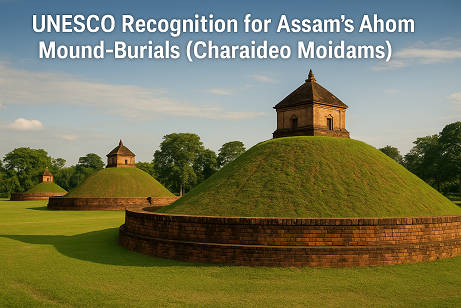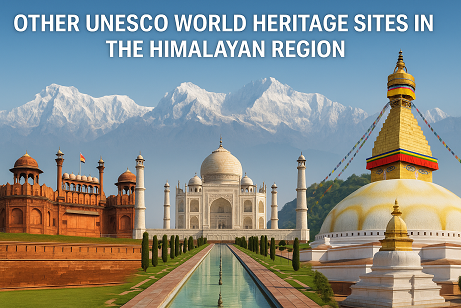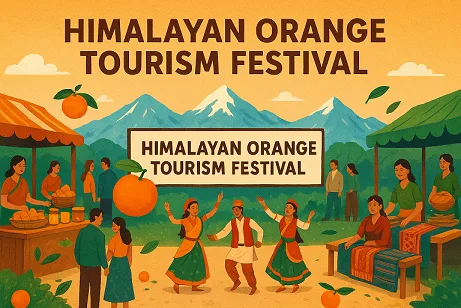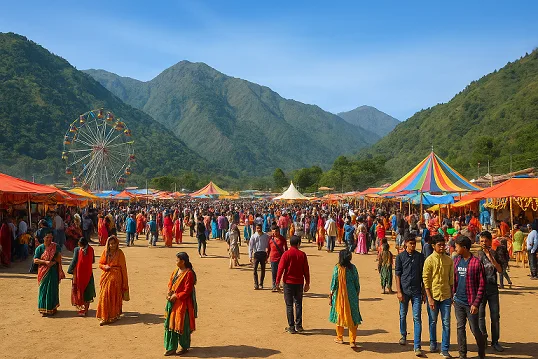What Are Charaideo Moidams?
The Charaideo Moidams are ancient burial mounds built by the Ahom rulers to lay their kings, queens, and royal families to rest. These mound-like tombs are similar in function and significance to the Egyptian pyramids or Chinese royal tombs.
The word “Moidam” is derived from the Tai-Ahom language. It means “grave” or “tomb”. These Moidams are found at Charaideo, the original capital of the Ahom Kingdom in eastern Assam.
Out of around 386 identified Moidams, nearly 90 are in well-preserved condition and represent the best examples of Tai-Ahom funerary architecture.
Where is Charaideo?
Charaideo is located at the foothills of the Patkai Range, in Upper Assam, around 30 km from Sivasagar. This region served as the first capital of the Ahom Kingdom, founded by Chao Lung Siu-Ka-Pha in the 13th century.
Coordinates: Approximately 27.0° N, 95.0° E
Historical Background of Ahom Dynasty
The Ahoms were a Tai group who migrated from present-day Yunnan (China) to Assam in 1228 CE. Their founder, Chao Lung Siu-Ka-Pha, established the Ahom rule, which continued for almost 600 years (1228 to 1826 CE).
Under their reign, Assam saw a golden age of governance, architecture, agriculture, and warfare. The Ahoms successfully resisted the Mughals multiple times and maintained a unique syncretic culture, combining local and Tai customs.
The Moidams reflect their beliefs in ancestor worship, spiritual afterlife, and royal divinity.
Structure and Architecture of Moidams
Each Moidam is a vaulted burial mound built for kings or nobles. The structure is both spiritual and symbolic.
Key components of a Moidam:
Vaulted Brick Chamber (Grave Room) – This is where the royal body was placed, often with belongings, food, animals, and even servants.
Earthen Hemispherical Mound (Ga-Moidam) – The chamber is covered with layers of earth to create a rounded hill-like shape.
Chou Cha Li (Shrine Room) – Located at the top, this shrine is meant for posthumous rituals and honors.
Garh (Octagonal Enclosure Wall) – Surrounds the mound, protecting the sacred space.
Mungklang (Soul Pillar) – Represents a spiritual connection between earth and heaven.
The octagonal design is said to represent the eight directions of the Tai-Ahom cosmology.
Religious and Cultural Significance
The Moidams are not just tombs. They are sacred spiritual sites. The Ahoms believed in ancestor worship. Even today, rituals like Me-Dam-Me-Phi and Tarpan are held at Charaideo, especially during Ahom festivals. These ceremonies pray to the ancestors for blessings, health, and protection.
The royal dead were considered semi-divine beings, and the entire burial system reflects that deep respect and spiritual belief.
UNESCO World Heritage Recognition – A Historic Moment
In July 2024, during the 46th session of the UNESCO World Heritage Committee in India, the Charaideo Moidams were officially inscribed in the UNESCO Cultural Heritage List. This marked India’s 43rd World Heritage Site, and the first cultural site from the Northeast region.
The nomination process took several years. The dossier was prepared by experts from the Archaeological Survey of India (ASI), Assam government, and heritage researchers.
The site fulfilled UNESCO criteria related to:
Unique architectural style
Cultural significance
Representation of a lost funeral tradition
Harmonious design with nature
The global recognition was widely celebrated across Assam and India. Prime Minister Narendra Modi and Chief Minister Himanta Biswa Sarma praised the achievement.
Why Are They Called the “Pyramids of Assam”?
Like the pyramids of Egypt, these Moidams are large, majestic burial monuments for royalty. Their round mound shape, hidden chambers, and spiritual role have drawn comparisons to ancient pyramid cultures.
However, the Moidams are unique to Assam’s geography and Tai-Ahom culture, giving them an identity of their own.
First Anniversary Celebrations – 2025
On 29 July 2025, Assam celebrated the first anniversary of the UNESCO tag with cultural programs, rituals, and official visits.
Tourism efforts were also boosted during this time. Heritage walkways, signage, and guides were introduced to attract more visitors. Educational workshops were held to raise awareness among locals.
Tourism and Development Impact
With the UNESCO tag, Charaideo Moidams are now part of global heritage tourism maps. This brings:
Increased tourist footfall (domestic & international)
Cultural awareness of Ahom traditions
New job opportunities in local areas
Boost in local handloom and handicraft markets
Conservation funding from UNESCO and the Government of India
Tour packages from Guwahati and Sivasagar now include a “Heritage Ahom Trail,” covering Rang Ghar, Kareng Ghar, and Charaideo Moidams.
Preservation and Challenges
The Archaeological Survey of India and Assam Tourism Department are now working together for:
Structural preservation of old mounds
Protection from illegal encroachments
Proper signage and visitor facilities
Training of local guides
Reforestation and landscape protection
However, there are still challenges like monsoon damage, lack of awareness, and slow infrastructure around Charaideo.
Conclusion
The UNESCO recognition of the Charaideo Moidams is not just a global award, but a matter of pride and responsibility for India—especially Assam and the Northeast.
It brings to light the rich legacy of the Ahom kings, their deep-rooted culture, and architectural wisdom. This is also a golden opportunity to boost sustainable tourism and protect one of the oldest royal cultures of India.
If you’re planning a heritage trip in India, especially the Northeast, a visit to Charaideo is a must. You won’t just see mounds—you’ll feel history, culture, and spirituality, all alive in one place.











